The Pikey Peak Trek in Nepal offers a stunning Himalayan panorama, including Everest, and a rich cultural experience. Known for its serene trails, vibrant Sherpa settlements, and breathtaking sunrises, it’s a less-crowded alternative to popular treks. Ideal for nature lovers and those seeking tranquility amidst Nepal’s majestic landscapes.
Pikey Peak Trek - 6 Days
Overview
The Pikey Peak Trek is one of the most scenic, short, and easy Himalayan treks near Kathmandu in Nepal. Located in the lower Khumbu Region of central-eastern Nepal, the trek explores the valleys, alpine ridges, and panoramic views from the Ganesh Himal range to the far east Kanchenjunga, including Mount Everest (8848m). Home to rare and protected birds and animals, the trekking area is also mainly inhabited by ethnic groups such as Tamang, Sherpa, Rai, Magar, Jirel, and Chettri. Tibetan Buddhism is the main religion in upper areas such as Salleri and Junbesi, while lower areas like Okhaldhunga blend Hindu and Buddhist practices, reflecting Nepal’s diverse traditions.
Pikey Peak Trek – A cultural journey. How?
When it comes to short trekking from Kathmandu without a mandatory expensive flight but yet a great scenic and cultural trek, it offers both stunning views of the Himalayas and a blend of nature and culture, equally beautiful compared to the legendary Everest Base Camp Trek, but at a very affordable price without Lukla flights. The trek rounds the lower Everest region in the Solukhumbu district, and the itinerary takes you through the lower part of the Khumbu area and reaches the Pikey Peak Summit at a height of 4065 meters, which provides a prominent viewpoint of Mount Everest without trekking to the Everest Base Camp, which is one of the highlights of the whole trek.
Nepal is a diverse country, housing different ethnic groups co-existing in perfect harmony. However, none of these groups don’t make a living in one particular area but are rather scattered throughout the country. To make it clearer, Nepal is divided into three main regions: The Himalayas, the Hills, and the Terai. In the same manner, the diversity of Nepal is also divided into, or rather changes depending on the region. And Pikey Peak Trek explores the hills and the lower Himalayas, which makes it a cultural trek as well. Though Buddhism dominates the trek, the overall journey is spiritually enlightening, with the main highlight along the way being Thupten Choling Monastery.
What’s special about Thupten Choling Monastery?
Thupten Choling is a living Tibetan Buddhist Monastery located above the village of Junbesi in Solukhumbu district, Koshi Province, Nepal. Roughly 80-100 permanent nuns and monks, and temporary meditators or practitioners, occupy the monastery currently.
During the year 1959 Chinese invasion of Tibet, many monks, including His Holiness Trulshik Rinpoche, fled Tibet. After leaving Tibet, Trulshik Rinpoche and his followers spent time in monasteries of the Khumbu Region, including Thame Monastery, until 1968, when the land above Junbesi was donated and Thupten Choling Monastery was built there. Trulshik Rinpoche saw the monastery as a temporary retreat and hoped to return to Tibet. So, the initial building was not strong or made for the long term, which later deteriorated, and with reconstruction, it became a permanent residence. Tibetan refugees were more than welcome in Solu, and due to proximity to other monasteries and followers, the monastery became a permanent home for monks and nuns.
The history is to let the trekkers know that Thupten Choling Monastery is more than just a house for monks and nuns; the monastery itself is a history that carries the conflict of Tibet and China. When it comes to knowledge of Buddhism, the monastery was founded during the time of His Holiness Trulshik Rinpoche himself, with all the Tibetan Buddhism still in practice and passed down. This makes the Pikey Peak Trek also a spiritual journey, along with a cultural journey, perfect for those who want to learn more about Tibetan Buddhism in Nepal along the trek.
Is this the right trek for you?
There are a few checklists before knowing if a trek is indeed for you. Before planning a trek, know what you want to get from the trek. Is it an unparalleled view of the Himalayas, a cultural trek, a wilderness trek far from regular trekkers, or a round trek of a whole region?
The Pikey Peak is a 6-day trek in the lower Khumbu. With a max elevation of 4065M above sea level, the trek passes through lush valleys of Dhap and heads towards the alpine ridges, and panoramic views of Everest and neighboring mountains. After a whole day's drive from Kathmandu to Dhap, the trek passes green, lush valleys and small villages with stupas in the hills. With the days, the vegetation shifts towards high meadows and dry grassy lands with rhododendrons dominating the major parts till Pikey Base Camp. The peak is the top of a dry hill, which serves as a viewpoint of the Great Himalayas from the Ganesh Himal Range to the far east Kanchenjunga (check our Kanchenjunga Base Camp Trek). Afterward comes the Junbesi, the village of Sherpas who are known for their rich monastic traditions, especially connected to Thupten Choling and the nearby monastery.
From these points, the Pikey Peak Trek can be more than a week’s journey to viewpoints. It is a trip of cultural, spiritual, and physical journey in the Himalayas. Those who seek to learn Tibetan Buddhism can also have a temporary retreat in Thupten Choling Monastery.
Is Pikey Peak the best short trek?
In short, yes, it is one of the best short treks in Nepal, which covers both scenic views and cultural aspects well. Though it may not take you close to the Himalayas but the panoramic view of the Himalayas from Pikey is something that can’t be compared either.
Pikey Peak is known for offering the best panoramic view of 80% of the whole Himalayas in one frame, along with rich, diverse Sherpa culture and its renowned Thupten Choling Monastery, which is also the highlight of the trek.
Comparing the Pikey Peak trek with other popular short treks, which cover both panoramic sights and cultural appearances, like the Langtang Valley trek.
Pikey Peak Trek or Langtang Valley trek, which is best to do?
Scenic views and the Himalayas: Both trek offers different experiences in terms of the view of the mountains. Pikey Peak takes you to a viewpoint from where the whole Himalayas, from the Ganesh Himal Range to the far east Kanchenjunga, can be seen. While, Langtang Valley trek takes you as close as possible, surrounded by the mountains.
Trekking Trails: The trail leading to Pikey Peak goes on top of a hill and forested areas, mostly on alpine meadows. The trail of Langtang Valley passes through dense forest of hills in the beginning and alpine valleys later.
Cultural aspects: The Langtang Valley Trek is also known for offering a peaceful, calm cultural experience. Since Langtang village is a Sherpa settlement, the trek revolves around traditions, rituals, and beliefs. As tourism intensified, Langtang became more tourism-focused, and the famous Kyanjin Gompa became more passive. This is also the main reason for Pikey Peak to be the choice for a cultural trek. Since the monastery in Junbesi is still actively running and passing on the knowledge.
Every trekking region is beautiful in its own way. The experience may differ due to the trekker’s personal choices as well. So, always be clear about what you want during your trek as well.
Best time to do the Pikey Peak trek
Trekking in Nepal is an adventure activity that many trekkers prefer to do during the seasonal months. When? Trekking seasons in Nepal start twice a year, from March to May/June and from September to November/December. Why? During these specific months, Nepal experiences Spring, Autumn, and early Winter. It is the perfect time for adventure activities due to stable weather, clear and crisp skies, dry trails, and seasonal festivals across the country. To get clearer, let’s break down what you experience during the different seasons.
March-June: Spring season (Pre-Monsoon)
- Less haze offers a panoramic view of the mountain range.
- Stable weather, perfect for adventure activities like trekking.
- Dry and safe trails.
- Colorful forest full of different flowers.
- Seasonal festivals in Villages.
September-November: Autumn season (Post-monsoon)
- Clear and crisp sky, offering the best panoramic view of the Himalayas.
- Ideal season for trekking.
- Perfect and stable weather, as the monsoon has ended.
- Forest with red and golden hues.
- Possible wildlife movement in the Himalayas.
- Safe trails and low possibility of landslides.
- Experience the greatest and longest festival of Nepal, Dashain and Tihar.
These two months are preferred by most trekkers due to their stable weather and safe trails, offering the best panoramic views. The months from September to November are considered the best time for trekking as the monsoon ends and the rain has cleared the dust.
Though some trekking is also preferred to be done during the monsoon, which is known as a monsoon trek. For more information, follow the given link.
Is Pikey Peak hike difficult for beginners?
In short, Pikey Peak trek ranks among the moderate level of treks. The trekking period is short, the altitude reached is 4065M, and the trails are actually beginner-friendly. Though the trekking difficulty can’t be determined by the number of walking days, altitude, and trails alone. Many other factors, such as accommodation along the way, trekking hours per day, food, and transportation, also play a vital role in trekking difficulty. So, is the Pikey Peak trek possible for a beginner trekker? The answer is YES.
In accordance with our standard itinerary of the Pikey Peak trek, the trek lasts for 6 days with 4 walking days and 2 road travel days. The trekking hour is also short, with a maximum walking time of an hour, no more than 8 hours. The trails from the very beginning start with a short roadway and a gradual uphill to Jhapre, from where it’s a moderately long uphill to Pikey Base Camp. Once you cross Pikey Peak, with an uphill once it’s usually downhill till Junbesi, and the last road trek to Salleri or Phaplu. About the foods and accommodation at Pikey Peak, it will be explained in more detail.
So, if you are a physically fit person, then yes, this trip is recommended for you. Since the Pikey Peak trek is also an all-age trek.
Accommodation and Food at Pikey Peak.
Though less developed than trekking regions like Langtang when it comes to accommodation and food, the Pikey Peak trek also doesn’t fall behind. Just like in any other renowned trekking area, Pikey Peak also follows a standard restaurant pattern with a variety of foods and drinks offered more locally.
Accommodation is usually consistent throughout the trek, with clean and spacious rooms with two beds per room. Though Lodges in Dhap, Jhapre, and Pikey Base Camp may not have attached bathrooms, they are usually clean and well-maintained. Lodges in Junbesi and Phaplu offer better accommodation when compared to other parts. Since it’s not a camp but rather a village and a town, which were also used as a stopping point in the history of Everest Trekking.
Highlights of the Pikey Peak Trek
The main highlight of the Pikey Peak trek is its stunning view of 80% of the whole Himalaya Range and the living Monastery of Junbesi, Thupten Choling Monastery. Pikey Peak trek is known for the panoramic view of the Himalayan Range with a cultural blend of rich Sherpa culture. Listed under the Gaurishankar Conservation Area, Pikey Peak is also home to rare species of birds and animals, with possible wildlife moments around Pikey Base Camp. Some of the main highlights of the Pikey Peak Trek can be: -
Flora and Fauna
- Himalayan Monal (Danphe) - Nepal’s national bird.
- Blood Pheasant and Kalij Pheasant.
- Blue whistling thrush and Himalayan Griffon Vulture.
- Himalayan Black Bear and Red Panda.
- Himalayan Tahr and Barking Deer.
- Langurs and Himalayan Monkeys.
Cultural Highlights
- Living Monastery of Junbesi – Thupten Choling Monastery.
- Mani walls and stupas along the routes.
- Rich Sherpa culture of Solu.
- Diverse culture Dhap.
Transportation to the Trek to Pikey Peak
To reach Pikey Peak is easy and simple. You can get a morning local jeep from Chabahil to Dhap, which takes around 8hr. Once you reach Dhap, the trail is friendly with route marks in most places and easily identifiable trails. From Dhap, the trail mostly follows the roadway to Jhapre, from where you pass through a dense jungle for an hour or two, and again follow a roadway for another hour or two till Bhulbule. Afterward, the trail passes through dense forest and alpine grasslands with constant uphill to Pikey Base Camp. From Pikey base camp, it's an uphill hike to Pikey peak and a downhill to a lodge and another uphill to Jasmane Bhanjyang. After crossing Jasmane Bhanjyang, it’s a downhill to Junbesi and a roadway to Phaplu, from where you can get a jeep ride back to Kathmandu.
Guide and porter cost for Pikey Peak trek.
The rate of guides and porters for trekking purposes is the same for every trek. Hiring a professional licensed trek guide costs you 25 to 30 USD per day and more for trek guides with optional language skills as well.
A porter can cost you 20 USD per porter per day. One porter for two trekkers is a standard recommendation with a maximum weight of 20-25kg. If you need a porter, you can order from the add-ons option while booking the trip with Wilderness Excursion.
For more information on hiring trek guides and porters in Nepal, follow the given link.
How much would be the cost per person for a 6 to 7-day Pikey Peak trip?
Embrace the Pikey Peak Trek, which is best suitable for “Budget wanderlust." By embarking on a money-saving trip, staying slightly outside the main tourist trails, like the iconic Everest Base Camp. At Wilderness Excursion, a well-managed budget isn’t about restriction; it’s about empowering you to experience more with peace of mind, ensuring your memories are rich long after you return home.
While planning Trekking in Nepal, a budget should not limit your adventure trekking experience. Here, at Wilderness Excursion with 14 years of excellence in arranging trekking tours, we have introduced a budget-friendly, uniquely beautiful Pikey Peak Trek at an affordable cost of USD 399 per person with a bucket list of inclusions of public bus transportation, an expert local guide, 3 cycle of meals every day, and a cozy trekking lodge accommodation on a twin-bed shared basis. We believe that the cost featured is suitable for students, youngsters, and budget travelers as well.
Extra costs and expenses that you will have to put aside while doing Pikey Peak are:
- Beverages: A bottle of 500ML Coke will cost NPR 200 (US$2) approximately.
- Taking a hot shower: NPR 150 to 200 a short (USD 1 to 2).
- Charging Camera /Mobile: NPR 150 to 200 (USD 2) for a full charge
- Using the internet, recharge the SIM Card: A local SIM Card, NPR 200 (USD 2), NTC is suggested if you buy.
- Tips and Gratitude: Tipping Guide and Porters (Should I tip the guide and porter?)
Additionally, you may drop a little donation in the monasteries you visit, and having a bottle of beer to celebrate your trek is optional; therefore, it depends on how much extra you spend. Typically, allowing USD 15 to 20 a day should be sufficient for extra costs.
Add-ons (If you prefer relaxing transportation), the extra cost will be:
- Kathamandu to Phaphu flight fare: USD 158 per person, and the same rate for the return flight (only Monday and Friday)
- Private Jeep: Upgrading the transportation to a comfortable private jeep will cost USD 230 for the group and the same rate for the way back.
Alternative Extended Itinerary via Jiri - Bhandar - Namkheli (Cost USD 699 per adult)
Day 1: Kathmandu to Bamti Bhandar.
Day 2: Bhandar – Namkheli
Day 3: Namkheli – Golla
Day 4: Golla – Pikey Base Camp
Day 5: Pikey Base Camp – Pikey Peak - Lamjura Danda or Jasmane Bhanjyang
Day 6: Lamjura or Jasmane Bhanjyang - Junbesi
Day 7: Junbesi – Thupten Choeling Monastery – Junbesi
Day 8: Junbesi – Chiwang - Phaplu
Day 9: Phaplu - Kathmandu
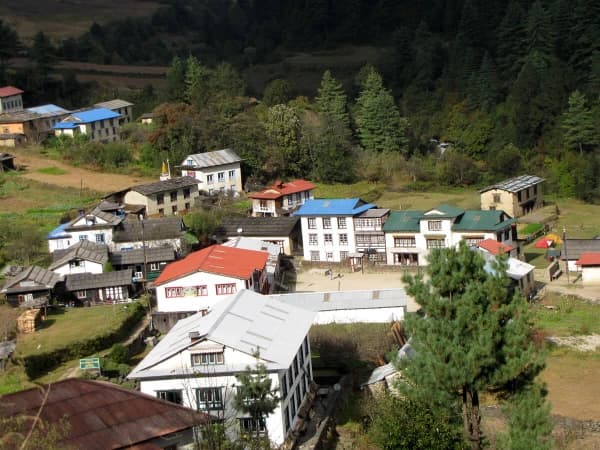
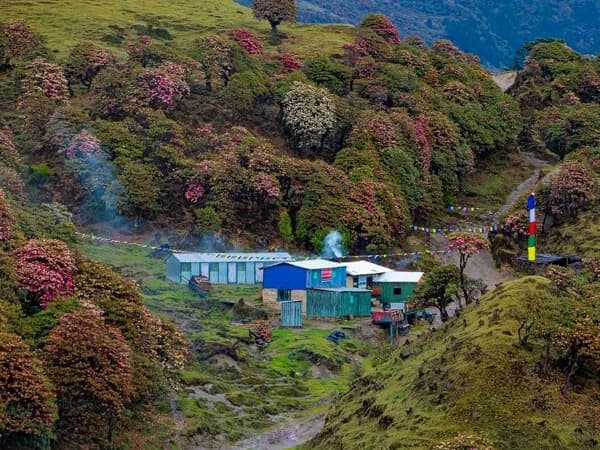
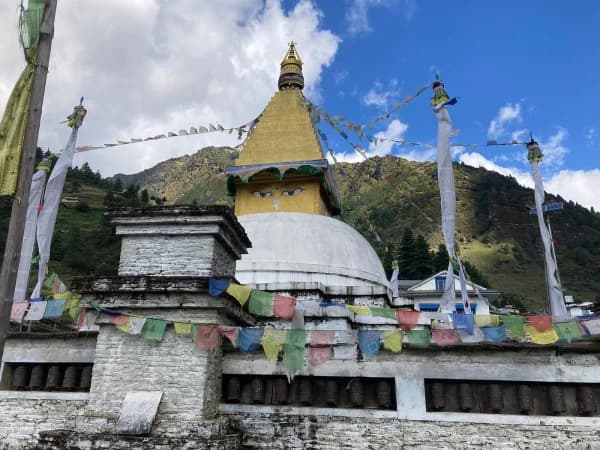


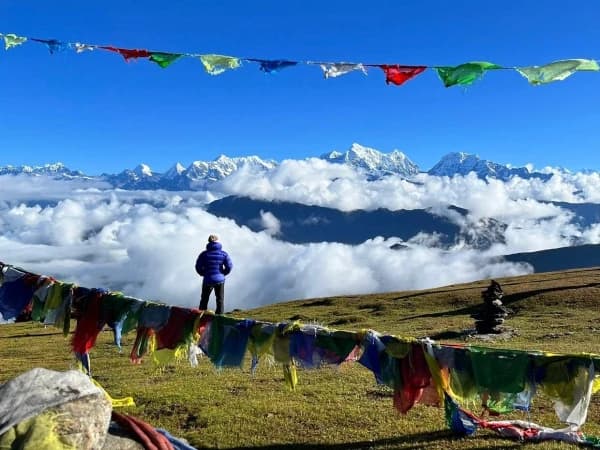


We begin our day by catching a local jeep from Kathmandu very early, at around 5 AM. Drive to Dhap will be some 8 to 9 hours, depending on traffic conditions. Stay overnight at Dhap in the local trekking lodge.
We start the trek, and as we near Sigane, the mountains that you will get to know very well come into view—the peaks of the Numbur Himal section of the Himalayan Range.
From Sigane, the trail road has been under construction for about two hours. The first village you get is Japre (2920 m/9580 ft), perched above a deep valley with nice views of Everest and Numbur Himal. There’s a pretty little Buddhist monastery and stupa here, and this is your stop for the night.
The trail goes up to a grassy ridge at Bhulbhule. There’s a lodge with a nice view of the Everest range. Soon after Bhulbhule, the trail splits, and you'll turn right to Pikey Peak. You’ll pass some old yak houses and a long mani stone wall. The trail then contours the hillside below Taklung Danda and goes through a lovely forested trail.
Walk through the rhododendron forest along a level path, which you can witness in bloom if trekking in the spring season. As soon as you leave the forested trail, it’s not long to Pikey Peak base camp, about a couple of hours away.
From Pikey Peak Base Camp, it's a short hike up to the summit at 4065 m / 13336 ft. We start early on a gradual trail to the top, covered with prayer flags. The views are wonderful! If the weather permits, you'll treasure the memory of the panoramic of 180 degrees from Kanchenjunga to Langtang Himalayan range.
After enjoying the view at Peak, we will head to Junbesi, a beautiful classic Sherpa Village consisting of many lodges and apple gardens. We can go for an excursion to Thupten Chholing Monastery if we arrive early at Junbesi.
It is a short and easy day today for Salleri. If you are strong enough and not tired, you can have a side trip to Chowong Gompa but if you would like to head to Salleri straight and relax, it is a 5-hour walk today.
Catch an early morning jeep to Kathmandu from Sallri. It takes about 10 to 11hours ride. Alternatively, flights to Kathmandu from Phaplu are available on Monday and Friday (Cost USD 154 per adult)
Our standard itinerary is 5 nights and 6 days, including spending a night at Pikey Peak Base Camp, and this is a generally comfortable plan suitable for all age groups and fitness levels. We are happy to personalize your trip as per your preferences. Contact the expert to customize if you would like to.


- Experienced English-speaking guide (registered for the Pikey Peak Trek).
- Meals: 5 breakfasts, 6 lunches, and 5 dinners during the trek.
- Accommodation: Teahouse and homestay stays on a twin/triple-sharing basis.
- Transportation: Shared public jeep/bus transfers to and from the trek.
- Permits: Pikey Peak Trekking permit (if applicable).
- Staff Coverage: Guide and porter fees, including all their expenses.
- Taxes & Documentation: All government taxes and necessary paperwork.
- Accommodation, meals, and transfers in Kathmandu.
- Guided sightseeing in Kathmandu.
- Bar bills and beverage bills
- Personal travel insurance, internet, phone calls, laundry.
- Rescue operation charge in case of emergency.
- Porter to carry your main pack (Cost USD 120)
- Tipping your guide and porter.
At Wilderness Excursion, we offer add-ons like accommodation booking, local porter, private jeep services - crafted to make your Pikey Peak trek safer, smoother, and more memorable.
- Accommodation booking in Kathmandu USD 45: We can book your accommodation in Kathmandu for your convenience according to your preference. We offer an affordable cost range from USD 45 to USD 150, depending on the hotel category.
- Private Jeep Service Cost USD 225: If you would like to upgrade the transportation to Dhap (the trekking start point) from Kathmandu by a 4WD private jeep will cost USD 225 for comfortable land travel.
- Porter Service Cost USD 120: Let our porter carry your heavy pack, and you focus on the charm of the trekking holiday. One porter between two trekkers will cost USD 120 for 6 days
Check our published date! If it doesn’t match, we are happy to customize your tour perfectly to suit your interests and needs. Contact us for creating a unique travel experience for you
Permits and entry fees
Pikey Peak trek falls under the Gaurishankar Conservation Area. So, trekkers are required to take a GCAP permit from the Nepal Tourism Board, which costs Nepali Rupees 3000 per person. For more information: https://wildernessexcursion.com/nepal-trekking-permit-and-fees
Packing and Preparation Tips
Pikey Peak is a moderately well-developed trekking region. Most of the lodges also sell everyday items from water bottles to sanitary needs. But there are a few tips you can use for a more comfortable journey.
- Layer packing, heavy and flexible items in the bottom, soft and vulnerable items on top.
- Layer your day clothes to avoid heatstroke.
- Carry a minimum 2L of water bottle.
- Avoid cotton clothes during the day.
- Pack down jackets for the night. Sleeping bags (If needed).
- A hat, a buff, sunglasses, and gloves.
- Sunscreen, lip balm, and sanitary items.
- Extra snacks, energy bars, and entertainment cards. (If needed).
- Small first aid kit with basic medicine and rehydration powders.
- Waterproof essentials like raincoats and rain cover for the bag.
For more information on packing and preparation when trekking in Nepal, follow the link given.
Travel safety information
Nepal is usually safe for travelling, since the country is tourism-focused and many remote areas are also familiar with trekking and touring. But applying a few precautions can be helpful when traveling for unexpected circumstances.
- Keep your documents separate and safe.
- Carry small hand knives or a Swiss knife.
- Save emergency contact information from the embassy and local police.
- Never trek alone and separate from the main groups.
For your information, a Phaplu flight can be delayed by a few hours or canceled for a day, or more rarely, it may happen even in the peak trekking season, but as an option, there are local jeeps or buses available to Kathmandu from Salleri in case the flight is cancelled. Pikey Peak Trek can be customized as per the client's requirements. And the length of the itinerary and the group size will differ the tour cost, so please kindly provide us your details for a tailored itinerary. International tour leaders are encouraged to get a special discounted rate and attractive complimentary.
Pikey Peak Trek, graded as “moderate” in terms of difficulty. It is considered a good trek for beginners with good health and a reasonable fitness level. Altitude gain is gradual, which reduces the risk of acute mountain sickness compared to higher treks.
Pikey Peak is situated in Nepal’s Solukhumbu District in the lower Everest region, standing at a height of 4,065 meters (13,337 ft) above sea level. It is famous for offering panoramic views of multiple 8,000-meter peaks, including Mount Everest, and provides an off-the-beaten-path cultural trekking experience in lush forests.
Pikey Peak Trekking typically last from 5 to 7 days depending on the itinerary and level of your pace and the side trips and rest days included in the trip.
Pikey Peak is approximately 60 to 70 km ( 40 miles) of hiking, plus a roughly 245 km drive from Kathmandu.
The highest altitude in Pikey Trek is Pikey Peak summit, which stands at an altitude of 4065 meters.
You are fit, strong, and able to carry your main pack; you will not need a porter, but if you are not sure of your strength, lasting 5 to 7 hours a day with your luggage. Wilderness Excursion suggests you hire one porter for two trekkers, which allows you to walk comfortably.
Avec une amie, nous avons contacté Pradip pour 6 jours de randonnées au Népal, escalader Pikey Peak et découvrir la culture népalaise.
Tout a été parfait de A à Z. Rahul notre guide et Luresh notre porteur étaient très...

Our Pikey Peak Trek with Wilderness Excursion was an incredible experience and amazing! The trekking adventure was made even more special by our awesome guide and porter team, who shared deep insights into Sherpa culture and the stunning Himalayan nature.
...What an amazing trip, it was a soul-warming journey for me!!
I just finished Pikey Peak Trek in Nepal and came back home. It was a fully wonderful experience...
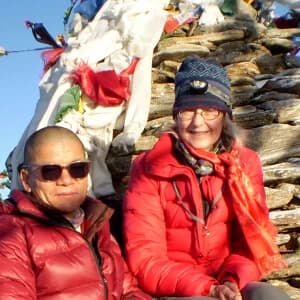
.webp&w=3840&q=75&dpl=dpl_CcHazofUWtxxcPG7rXgNGJzBcmvR)




